Imperceptible Flicker Noise Reduction Using Pseudo-Flicker Weight Functionalized Derivative Equalization in Light-Fidelity Transmission Link
Abstract
1. Introduction
2. Pseudo-Flicker Weight Functionalized Derivative Equalization in Li-Fi Transmission
3. Experimental Setup
4. Experimental Results
5. Conclusions
Author Contributions
Funding
Institutional Review Board Statement
Informed Consent Statement
Data Availability Statement
Acknowledgments
Conflicts of Interest
References
- Hass, H. LiFi is a paradigm-shifting 5G technology. Rev. Phys. 2017, 3, 26–31. [Google Scholar] [CrossRef]
- Albraheem, L.I.; Alhudaithy, L.H.; Aljaser, A.A.; Aldhaan, M.R.; Bahliwah, G.M. Toward designing a Li–Fi-based hierarchical IoT architecture. IEEE Access 2018, 6, 40811–40825. [Google Scholar] [CrossRef]
- Arai, S.; Kinoshita, M.; Yamazato, T. Optical wireless communication: A candidate 6G technology? IEICE Trans. Fundam. Electron. Commun. Comput. Sci. 2021, 104, 227–234. [Google Scholar] [CrossRef]
- Ariyanti, S.; Suryanegara, M. Visible light communication (VLC) for 6G technology: The potency and research challenges. In Proceedings of the 2020 Fourth World Conference on Smart Trends in Systems, Security and Sustainability (WorldS4), London, UK, 27–28 July 2020. [Google Scholar]
- Wu, X.; Soltani, M.D.; Zhou, L.; Safari, M.; Haas, H. Hybrid LiFi and WiFi Networks: A Survey. IEEE Commun. Surv. Tutor. 2021, 23, 1398–1420. [Google Scholar] [CrossRef]
- Chowdhury, M.Z.; Hasan, M.K.; Shahjalal, M.; Hossan, M.T.; Jang, Y.M. Optical Wireless Hybrid Networks: Trends, Opportunities, Challenges, and Research Directions. IEEE Commun. Surv. Tutor. 2020, 22, 930–966. [Google Scholar] [CrossRef]
- Wilkins, A.; Veitch, J.; Lehman, B. LED lighting flicker and potential health concerns: IEEE standard PAR1789 update. In Proceedings of the 2010 IEEE Energy Conversion Congress and Exposition, Atlanta, GA, USA, 12–16 September 2010. [Google Scholar]
- IEEE Std. 1789-2015; IEEE Recommended Practices for Modulating Current in High-Brightness LEDs for Mitigating Health Risks to Viewers. IEEE: Piscataway, NJ, USA, 2015.
- Burns, S.A.; Elsner, A.E.; Kreitz, M.R. Analysis of nonlinearities in the flicker ERG. Optom. Vis. Sci. 1992, 69, 95–105. [Google Scholar] [CrossRef] [PubMed]
- Cai, R.; Cobben, J.F.G.; Myrzik, J.M.A.; Blom, J.H.; Kling, W.L. Flicker response of different lamp types. IET Gener. Transm. Distrib. 2009, 3, 816–824. [Google Scholar] [CrossRef]
- Mejia, C.E.; Georghiades, C.N.; Abdallah, M.M.; Al-Badarneh, Y.H. Code design for flicker mitigation in visible light communications using nite state machines. IEEE Trans. Commun. 2017, 65, 2091–2100. [Google Scholar] [CrossRef]
- Oh, M. A flicker mitigation modulation scheme for visible light communications. In Proceedings of the 2013 15th International Conference on Advanced Communications Technology (ICACT), PyeongChang, Republic of Korea, 27 January 2013. [Google Scholar]
- Fang, J.; Che, Z.; Jiang, Z.L.; Yu, X.; Yiu, S.-M.; Ren, K.; Tan, X.; Chen, Z. An efficient flicker-free FEC coding scheme for dimmable visible light communication based on polar codes. IEEE Photonics J. 2017, 9, 1–10. [Google Scholar] [CrossRef]
- Han, Y.; Kim, Y.; Kim, B.W. Bit-Shuffle Coding for Flicker Mitigation in Visible Light Communication. IEEE Access 2019, 7, 150271–150279. [Google Scholar] [CrossRef]
- Liu, L.; Chen, L.K. Four-level flicker-mitigation coding scheme in the non line-of-sight optical camera communication system. In Proceedings of the Optoelectronics and Communications Conference (OECC), Hong Kong, China, 3–7 July 2021. [Google Scholar]
- Sun, L.; Han, Y. A capacitorless and low-optical-flicker AC direct LED driving IC and system applied to street lighting. IEEJ Trans. Electr. Electron. Eng. 2021, 16, 1013–1024. [Google Scholar] [CrossRef]
- Chong, K.H.; Gao, Y.; Mok, P.K.T. A customized AC hybrid LED driver with flicker reduction for high nominal range applications. IEEE Trans. Circuits Syst. II Express Briefs 2021, 68, 1635–1639. [Google Scholar] [CrossRef]
- IEEE P802.15 Working Group for Wireless Personal Area Networks (WPANs): Flicker Mitigation solutions of PHYs in IEEE802.15.7. Available online: https://www.ieee802.org/15/pub/TG13.html (accessed on 4 June 2018).
- IEEE P802.11 Light Communications Study Group: Commercial Solutions for Classified (CSfC) for Li-Fi. Available online: https://www.ieee802.org/11/ (accessed on 28 April 2018).
- ELIoT: Enhance Lighting for the Internet of Things. Available online: www.eliot-h2020.eu (accessed on 1 January 2019).
- Won, Y.-Y.; Yoon, S.M.; Seo, D. Ambient LED Light Noise Reduction Using Adaptive Differential Equalization in Li-Fi Wireless Link. Sensors 2021, 21, 1060. [Google Scholar] [CrossRef] [PubMed]
- Personick, S.D. Receiver design for digital fiber optic communication systems, II. Bell Syst. Tech. J. 1973, 52, 875–886. [Google Scholar] [CrossRef]
- Pang, G.; Zhou, Y. Functional limit theorems for a new class of non-stationary shot noise processes. Stoch. Process. Appl. 2018, 128, 505–544. [Google Scholar] [CrossRef]
- Rudin, L.I.; Osher, S.; Fatemi, E. Nonlinear total variation based noise removal algorithms. Phys. D 1992, 60, 259268. [Google Scholar] [CrossRef]
- Yılmazlar, I.; Sabuncu, M. Speckle noise reduction based on induced mode Hopping in a semiconductor laser diode by drive current modulation. Opt. Laser Technol. 2015, 73, 19–22. [Google Scholar] [CrossRef]
- Yılmazlar, I.; Sabuncu, M. Implementation of a Current Drive Modulator for Effective Speckle Suppression in a Laser Projection System. IEEE Photonics J. 2015, 7, 1–6. [Google Scholar] [CrossRef]
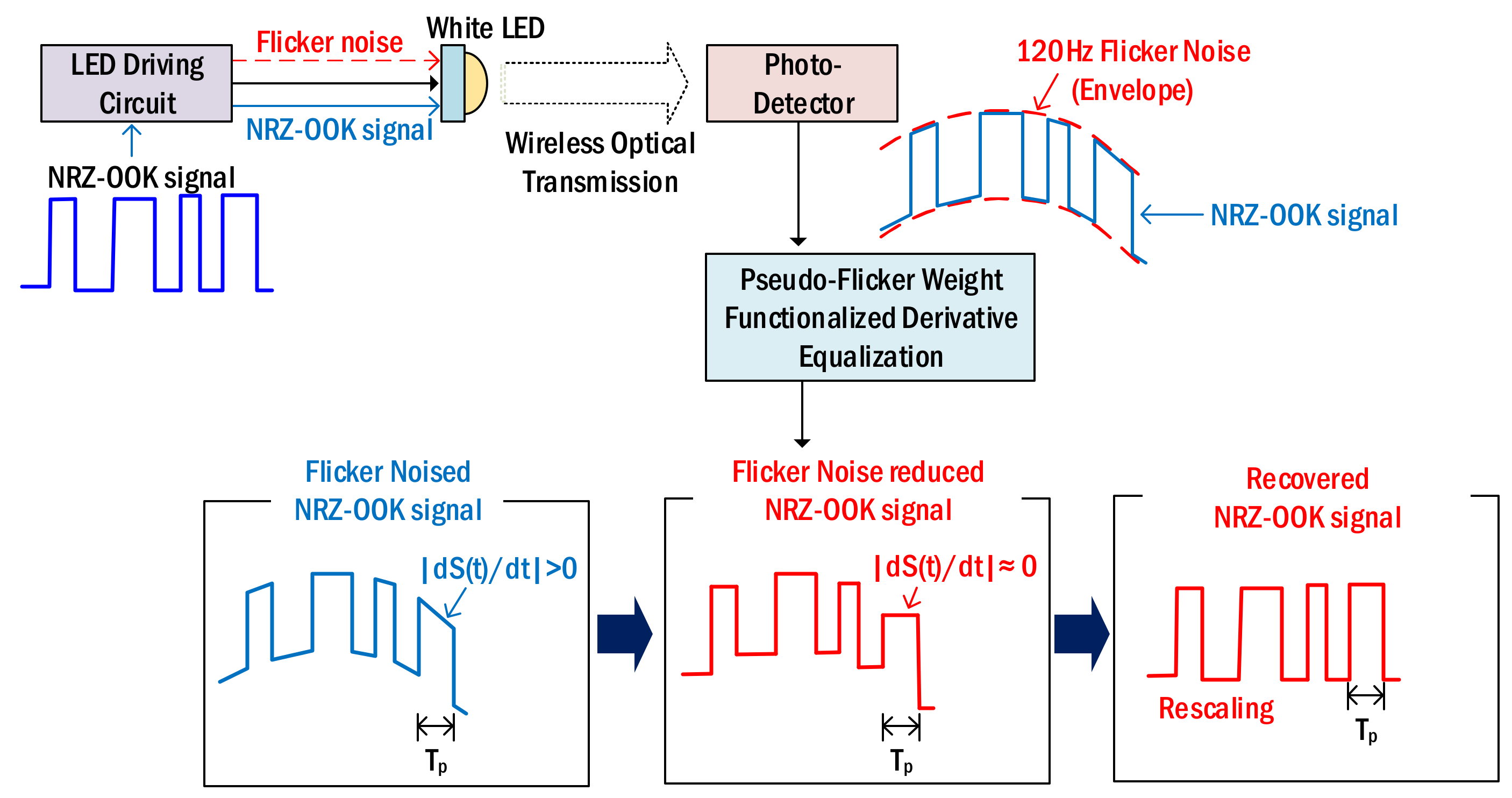
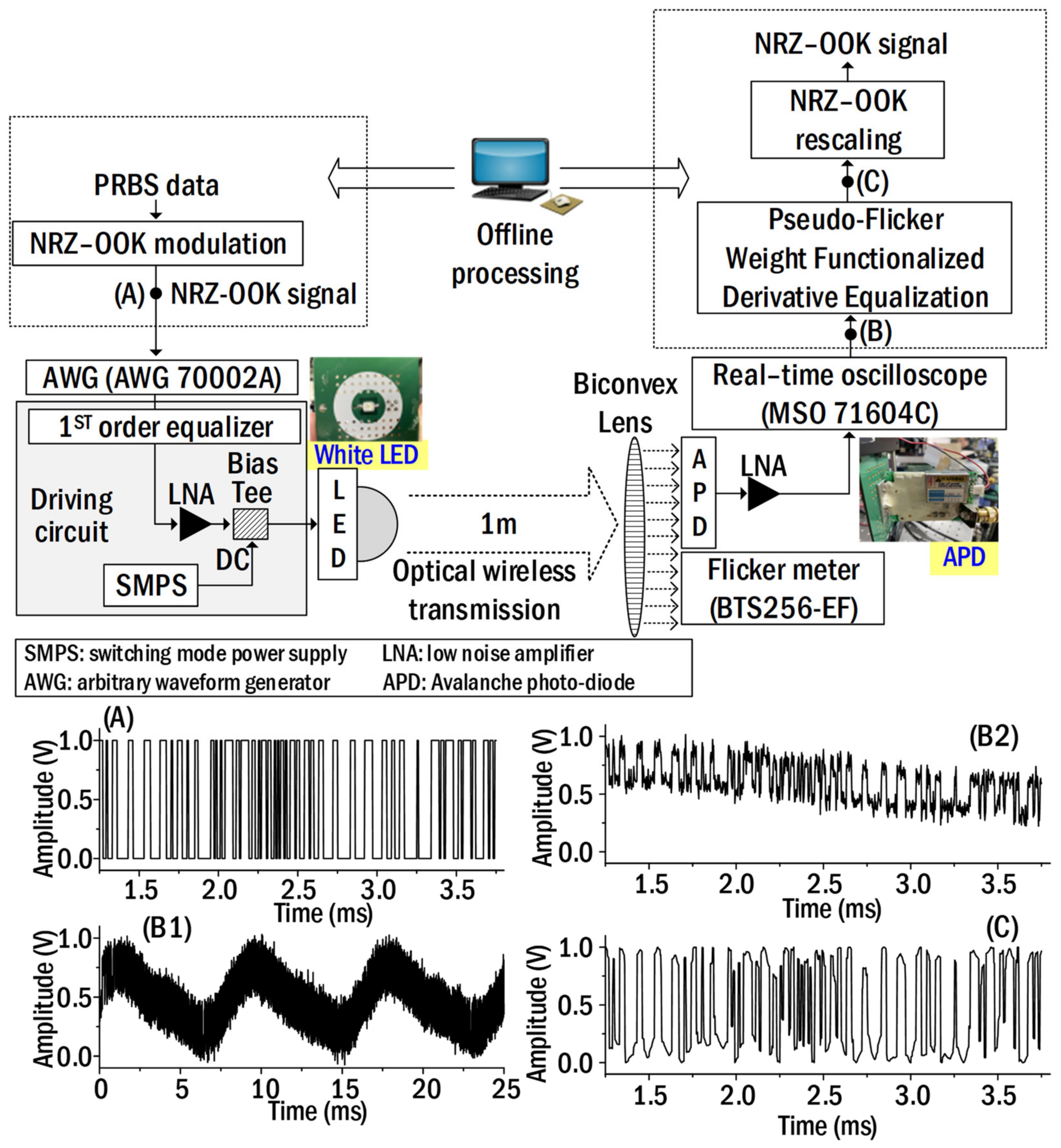
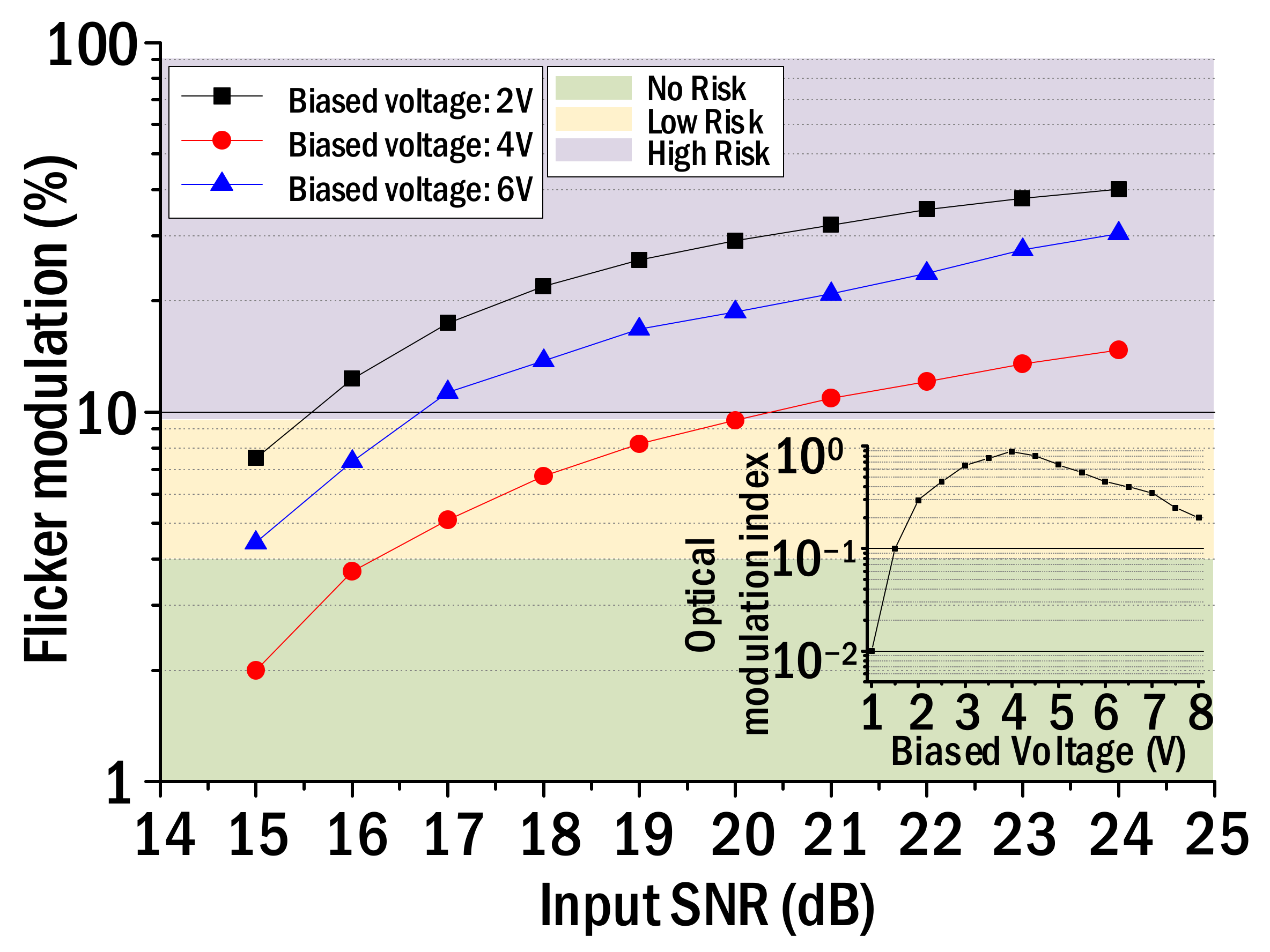
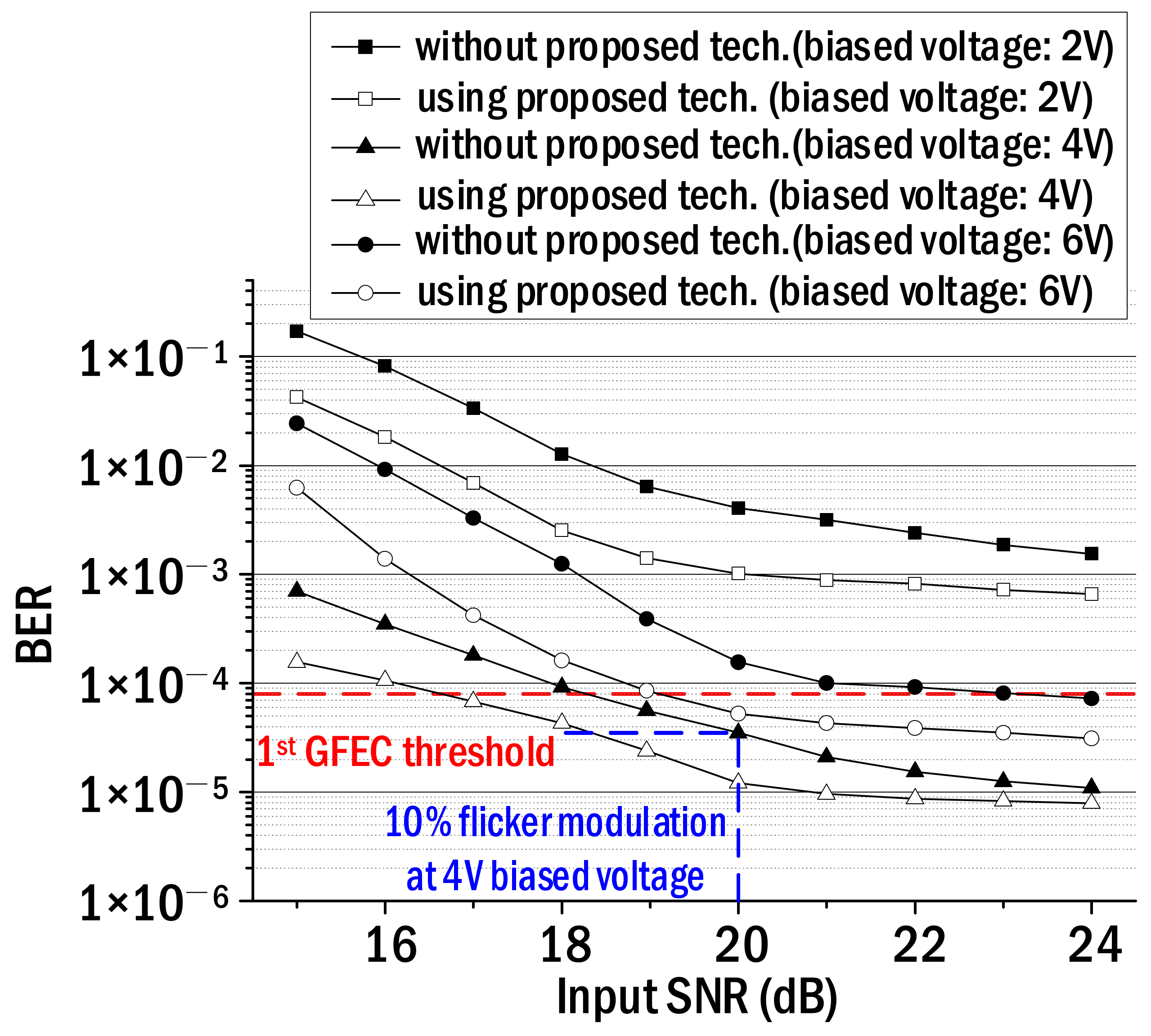
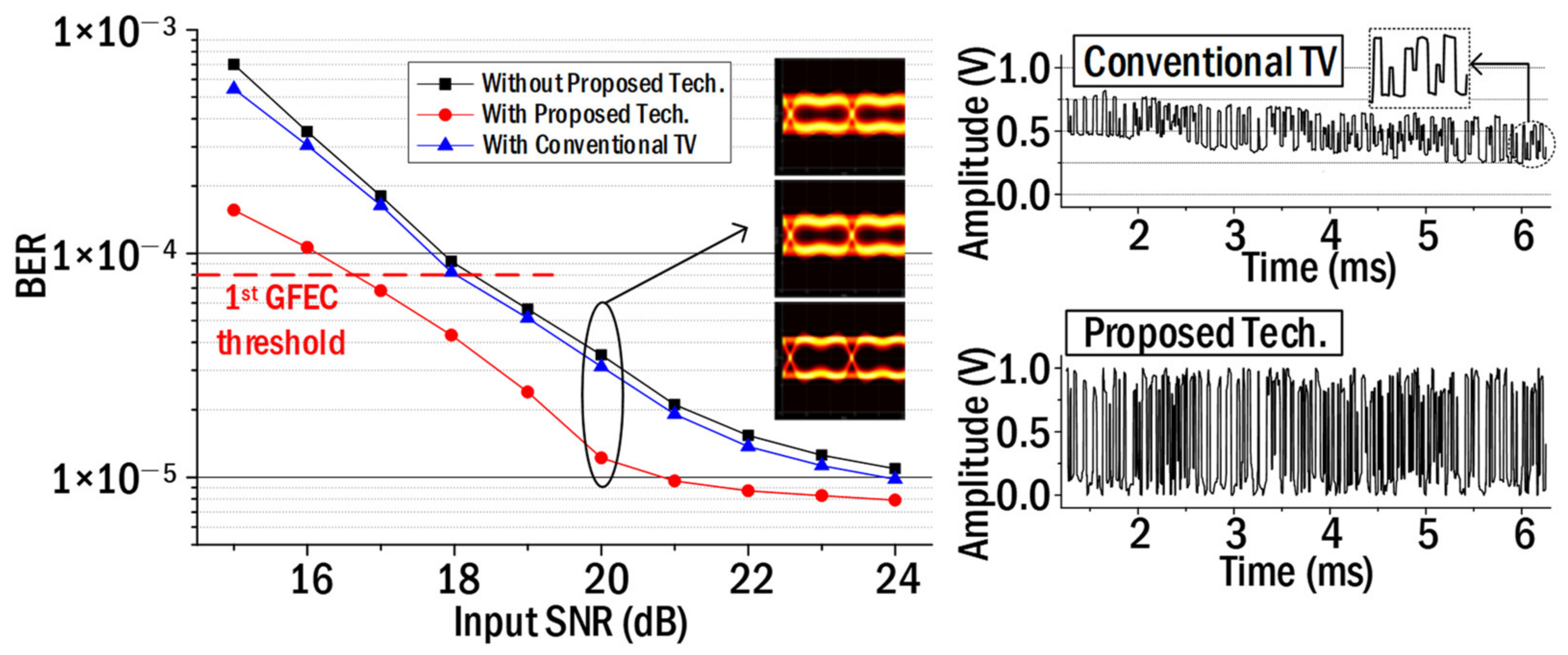

| Technique | Advantages and Weakness | Location |
|---|---|---|
|
|
|
|
|
|
|
|
|
| Technique | Differences | Similarities |
|---|---|---|
|
|
|
|
|
Publisher’s Note: MDPI stays neutral with regard to jurisdictional claims in published maps and institutional affiliations. |
© 2022 by the authors. Licensee MDPI, Basel, Switzerland. This article is an open access article distributed under the terms and conditions of the Creative Commons Attribution (CC BY) license (https://creativecommons.org/licenses/by/4.0/).
Share and Cite
Won, Y.-Y.; Kang, J. Imperceptible Flicker Noise Reduction Using Pseudo-Flicker Weight Functionalized Derivative Equalization in Light-Fidelity Transmission Link. Sensors 2022, 22, 8857. https://doi.org/10.3390/s22228857
Won Y-Y, Kang J. Imperceptible Flicker Noise Reduction Using Pseudo-Flicker Weight Functionalized Derivative Equalization in Light-Fidelity Transmission Link. Sensors. 2022; 22(22):8857. https://doi.org/10.3390/s22228857
Chicago/Turabian StyleWon, Yong-Yuk, and Jeungmo Kang. 2022. "Imperceptible Flicker Noise Reduction Using Pseudo-Flicker Weight Functionalized Derivative Equalization in Light-Fidelity Transmission Link" Sensors 22, no. 22: 8857. https://doi.org/10.3390/s22228857
APA StyleWon, Y.-Y., & Kang, J. (2022). Imperceptible Flicker Noise Reduction Using Pseudo-Flicker Weight Functionalized Derivative Equalization in Light-Fidelity Transmission Link. Sensors, 22(22), 8857. https://doi.org/10.3390/s22228857







